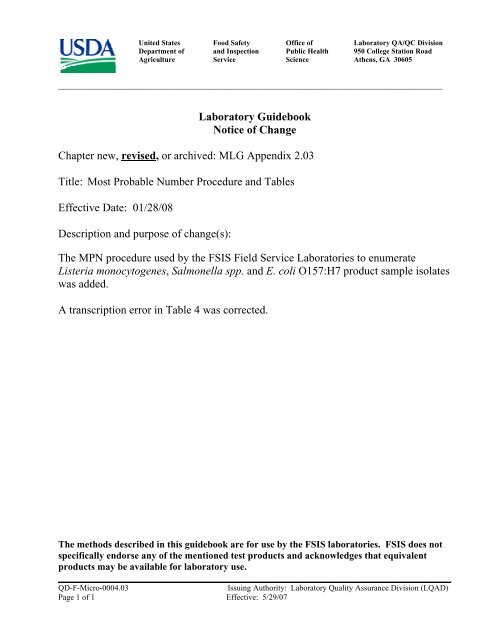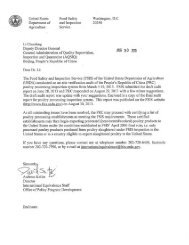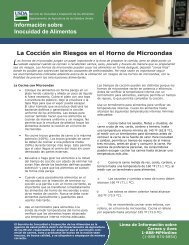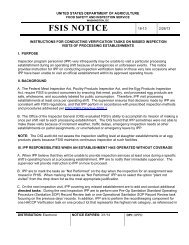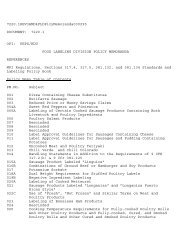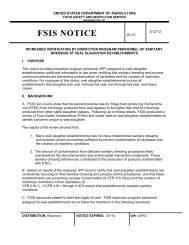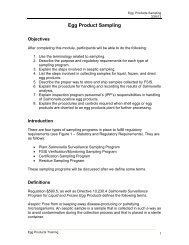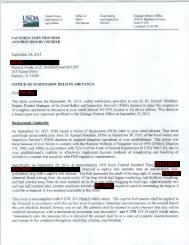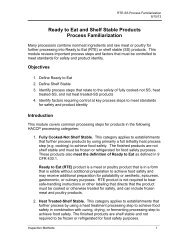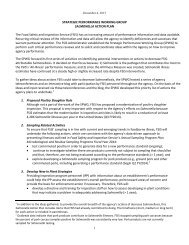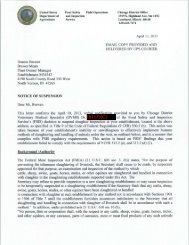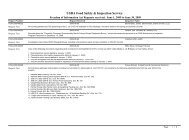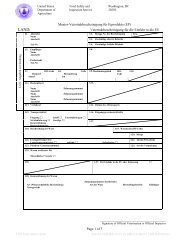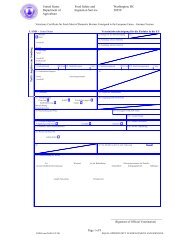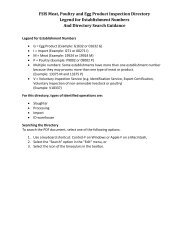FSIS Most Probable Number Procedure and Tables - Food Safety ...
FSIS Most Probable Number Procedure and Tables - Food Safety ...
FSIS Most Probable Number Procedure and Tables - Food Safety ...
Create successful ePaper yourself
Turn your PDF publications into a flip-book with our unique Google optimized e-Paper software.
United States<br />
Department of<br />
Agriculture<br />
<strong>Food</strong> <strong>Safety</strong><br />
<strong>and</strong> Inspection<br />
Service<br />
Office of<br />
Public Health<br />
Science<br />
Laboratory QA/QC Division<br />
950 College Station Road<br />
Athens, GA 30605<br />
_______________________________________________________________________________________________<br />
Laboratory Guidebook<br />
Notice of Change<br />
Chapter new, revised, or archived: MLG Appendix 2.03<br />
Title: <strong>Most</strong> <strong>Probable</strong> <strong>Number</strong> <strong>Procedure</strong> <strong>and</strong> <strong>Tables</strong><br />
Effective Date: 01/28/08<br />
Description <strong>and</strong> purpose of change(s):<br />
The MPN procedure used by the <strong>FSIS</strong> Field Service Laboratories to enumerate<br />
Listeria monocytogenes, Salmonella spp. <strong>and</strong> E. coli O157:H7 product sample isolates<br />
was added.<br />
A transcription error in Table 4 was corrected.<br />
The methods described in this guidebook are for use by the <strong>FSIS</strong> laboratories. <strong>FSIS</strong> does not<br />
specifically endorse any of the mentioned test products <strong>and</strong> acknowledges that equivalent<br />
products may be available for laboratory use.<br />
_________________________________________________________________________________<br />
QD-F-Micro-0004.03 Issuing Authority: Laboratory Quality Assurance Division (LQAD)<br />
Page 1 of 1 Effective: 5/29/07
United States Department of Agriculture<br />
<strong>Food</strong> <strong>Safety</strong> And Inspection Service, Office of Public Health Science<br />
MLG Appendix 2.03<br />
Title: <strong>Most</strong> <strong>Probable</strong> <strong>Number</strong> <strong>Procedure</strong> <strong>and</strong> <strong>Tables</strong><br />
Page 1 of 8<br />
Revision: 03 Replaces: 02 Effective: 01/28/08<br />
APP 2 <strong>Procedure</strong><br />
APP 2.1 Introduction<br />
APP 2.1.1 For the convenience of analysts using the procedures in this Guidebook, tables of<br />
<strong>Most</strong> <strong>Probable</strong> <strong>Number</strong>s (MPN) are provided in this appendix.<br />
APP 2.1.2 MPN is a procedure to estimate the population density of viable microorganisms in a<br />
test sample. It is based upon the application of the theory of probability to the<br />
numbers of observed positive growth responses to a st<strong>and</strong>ard dilution series of<br />
sample inoculum placed into a set number of culture media tubes. Positive growth<br />
response after incubation may be indicated by such observations as gas production in<br />
fermentation tubes or visible turbidity in broth tubes, depending upon the type of<br />
media employed. The sample should be diluted in such a manner that higher<br />
dilutions of the sample will result in fewer positive culture tubes in the series. The<br />
number of sample dilutions to be prepared is generally based on the expected<br />
population contained within the sample. If particularly high microbial populations<br />
are expected, the sample must be diluted to a range where the MPN can be obtained.<br />
<strong>Most</strong> reliable results occur when all tubes at the lower dilution are positive <strong>and</strong> all<br />
tubes at the higher dilution are negative. Generally tenfold serial dilutions are used<br />
in either a 3, 5 or 10 tube MPN series. When a higher number of tubes are<br />
inoculated in the series, the confidence limits of the MPN are narrowed. For<br />
particularly high microbial populations, the values obtained by MPN are generally<br />
not considered to be as precise as population numbers derived from direct plating<br />
methods; however, it should be emphasized that MPN values are only estimates<br />
while plate counts are direct counts of living organisms expressed in cfu/ml. MPN<br />
values are, however, particularly useful when low concentrations of organisms<br />
(
United States Department of Agriculture<br />
<strong>Food</strong> <strong>Safety</strong> And Inspection Service, Office of Public Health Science<br />
MLG Appendix 2.03<br />
Title: <strong>Most</strong> <strong>Probable</strong> <strong>Number</strong> <strong>Procedure</strong> <strong>and</strong> <strong>Tables</strong><br />
Page 2 of 8<br />
Revision: 03 Replaces: 02 Effective: 01/28/08<br />
APP 2.1.4 The following 4 tables present MPN values <strong>and</strong> corresponding 95% confidence<br />
limits for a 3 tube test series using 4 different, commonly used sets of inoculum<br />
quantities that should be particularly useful relative to performing the<br />
microbiological analyses previously described in various chapters of this Guidebook.<br />
These MPN tables may be considered to be abbreviated since not all possible<br />
combinations of positive <strong>and</strong> negative tubes within a series are presented. Those<br />
combinations that occur often enough to have statistical significance are included,<br />
while those that are improbable have been omitted. If laboratory analyses produce<br />
combinations that are not included in the tables, then one should repeat the test on<br />
another portion of the original sample (assuming the microbiological integrity of the<br />
sample has not been compromised) as a possible performance error or contamination<br />
is indicated. If this is not possible <strong>and</strong> an MPN is imperative, then more complete<br />
tables should be consulted from other reference sources or the MPN can be<br />
calculated by equation (other reference sources) on the basis of the observed results.<br />
APP 2.1.5 On occasions when more than three dilutions of a sample are used in a decimal<br />
series of dilutions of a 3-tube MPN determination; the following guidelines should<br />
be followed. Results from only three consecutive dilutions are used to determine<br />
the MPN. If one or more dilutions have all tubes positive, select the highest<br />
dilution (smallest sample quantity) with positive results in all tubes <strong>and</strong> the next<br />
two higher dilutions, as shown in examples a <strong>and</strong> b below. When none of the<br />
dilutions yield all tubes positive, select the three lowest dilutions for which the<br />
middle dilution contains the positive result, as shown in example c below. If a<br />
positive result occurs in a higher unselected dilution, add the number of positive<br />
tubes in this dilution to the results of the highest dilution of the three selected, as<br />
shown in example d below. When all dilutions tested yield all tubes positive,<br />
select the three highest dilutions (example e below). For additional information on<br />
MPN estimations, consult the APHA’s Compendium of Methods for the<br />
Microbiological Examination of <strong>Food</strong>s (3 rd edition, 1992, chapter 6).<br />
APP 2.2 SAMPLE PREPARATION FOR MOST PROBABLE NUMBER (MPN)<br />
A series of 3 sequential MPN tubes may be inoculated directly from the 1:10<br />
sample-culture medium homogenate if a low level of organisms is expected.<br />
Prepare the sample in the initial culture medium as directed for the analysis. Set up<br />
3 empty tubes <strong>and</strong> 6 tubes that contain 9 ml of the appropriate culture medium.<br />
Add 10 mL of the homogenate to each of 3 empty tubes, 1 mL of the homogenate<br />
to each of 3 tubes of culture medium, <strong>and</strong> 0.1 mL to each of the last 3 tubes of<br />
culture medium. This series of tubes represents 1.0, 0.1 <strong>and</strong> 0.01 g of sample. The<br />
remainder of the sample homogenate should also be cultured.<br />
Approved by Laboratory Quality Assurance Division (LQAD)
United States Department of Agriculture<br />
<strong>Food</strong> <strong>Safety</strong> And Inspection Service, Office of Public Health Science<br />
MLG Appendix 2.03<br />
Title: <strong>Most</strong> <strong>Probable</strong> <strong>Number</strong> <strong>Procedure</strong> <strong>and</strong> <strong>Tables</strong><br />
Page 3 of 8<br />
Revision: 03 Replaces: 02 Effective: 01/28/08<br />
Volume of Original<br />
Sample<br />
Alternatively, prepare serial 10-fold dilutions of the sample in the appropriate<br />
culture medium <strong>and</strong> follow the outline below. This is the preferred method if it is<br />
anticipated that the level of organisms may exceed 10 growth units per gram.<br />
Source of<br />
Inoculum<br />
Quantity of<br />
Inoculum<br />
Quantity of<br />
Culture<br />
Medium<br />
10 mL Sample 10.0 mL 90 mL 3<br />
1.0 mL Sample 1.0 mL 9.0 mL 3<br />
0.1 mL Dilution Tube 10-1 1.0 mL 9.0 mL 3<br />
0.01 mL Dilution Tube 10-2 1.0 mL 9.0 mL 3<br />
0.001 mL Dilution Tube 10-3 1.0 mL 9.0 mL 3<br />
0.0001 mL Dilution Tube 10-4 1.0 mL 9.0 mL 3<br />
<strong>Number</strong> of<br />
Tubes<br />
To increase sensitivity in samples expected to have a low level of the organism of<br />
interest, the <strong>FSIS</strong> laboratories perform the following procedure to prepare most<br />
product samples for pathogen MPN analysis.<br />
Start with a 65 ± 2 g test portion (representative of the entire sample) taken from<br />
the sample reserve. Add 585 ml enrichment broth <strong>and</strong> stomach for 2 minutes.<br />
Set up a 3-tube 5-dilution MPN (i.e., 15 individual dilutions for each sample)<br />
representing 10, 1, 0.1, 0.01, <strong>and</strong> 0.001 g of sample. Three containers will hold<br />
100 ml homogenate each to represent the 10 g sample dilution. Three containers<br />
will hold 10 ml homogenate each to represent the 1 g sample dilution. Three<br />
containers will hold 1 ml homogenate plus 9 ml enrichment broth each to<br />
represent the 0.1 g sample dilution. Three tubes will contain 0.1 ml homogenate<br />
plus 9.9 ml enrichment broth each to represent the 0.01 g sample dilution; <strong>and</strong> add<br />
0.1 homogenate to 9.9 ml enrichment, vortex, <strong>and</strong> add 1.0 ml from that dilution to<br />
each of three tubes containing 9.0 ml enrichment for the 0.001 g sample dilution.<br />
Analyze each dilution (<strong>and</strong> the remainder of the sample homogenate) per<br />
appropriate MLG chapter. MPN dilutions <strong>and</strong> the remainder of the sample<br />
homogenate that screen positive will be confirmed.<br />
Approved by Laboratory Quality Assurance Division (LQAD)
United States Department of Agriculture<br />
<strong>Food</strong> <strong>Safety</strong> And Inspection Service, Office of Public Health Science<br />
MLG Appendix 2.03<br />
Title: <strong>Most</strong> <strong>Probable</strong> <strong>Number</strong> <strong>Procedure</strong> <strong>and</strong> <strong>Tables</strong><br />
Revision: 03<br />
Replaces: 02<br />
APP 2.3 Completion of the MPN<br />
Page 4 of 8<br />
Effective: 01/28/08<br />
After all MPN dilutions have been completed, refer to the MLG for each pathogen<br />
being analyzed to determine incubation times <strong>and</strong> temperatures <strong>and</strong> procedures<br />
for completion of the analyses.<br />
APP 2.4 Example calculations<br />
Sample quantities (g or ml) 1<br />
Example 10 1 0.1 0.01 0.001<br />
a<br />
b<br />
c<br />
d<br />
e<br />
3/3 2<br />
3/3<br />
0/3<br />
3/3<br />
3/3<br />
APP 2.5 Reference(s):<br />
3/3<br />
3/3<br />
0/3<br />
3/3<br />
3/3<br />
2/3<br />
3/3<br />
1/3<br />
2/3<br />
3/3<br />
0/3<br />
2/3<br />
0/3<br />
1/3<br />
3/3<br />
0/3<br />
0/3<br />
0/3<br />
1/3<br />
3/3<br />
Reported<br />
positive<br />
values<br />
3-2-0<br />
3-2-0<br />
0-1-0<br />
3-2-2<br />
3-3-3<br />
MPN<br />
estimate/<br />
g or ml<br />
9.3<br />
93.<br />
0.31<br />
21.<br />
>1100<br />
1 The analyst should make sure that ALL sample dilution factors (including<br />
the preparation of any sample homogenate) are correctly applied in<br />
calculating the actual sample quantities subjected to MPN analysis.<br />
b2 Numerator No. positive tubes<br />
___________ = ____________________<br />
Denominator No. tubes inoculated<br />
Blodgett, R. FDA Bacteriological Analytical Manual Online, Appendix 2, <strong>Most</strong><br />
<strong>Probable</strong> <strong>Number</strong> Determination from Serial Dilutions, 2006.<br />
Swanson, K.M.J, R. L. Petran <strong>and</strong> J. H. Hanlin. Chapter 6, Culture Methods for<br />
Enumeration of Microorganisms in “Compendium of Methods for the<br />
Microbiological Examination of <strong>Food</strong>s” Fourth Edition, 2001. Edited by F. P.<br />
Downes <strong>and</strong> K. Ito. Published by American Public Health Association.<br />
Approved by Laboratory Quality Assurance Division (LQAD)
MLG Appendix 2.03 MPN Table 1. Page 5 of 8<br />
Table 1. MPN Index <strong>and</strong> 95% Confidence Limits for Various<br />
Combinations of Positive Tubes in a 3 Tube Dilution Series Using<br />
Inoculum Quantities of 10, 1 <strong>and</strong> 0.1 g (ml).<br />
Combination of MPN Index 95% Confidence Limits<br />
Positives per g (ml) Lower Upper<br />
0-0-0 11. 4.2 ---<br />
Approved by Laboratory Quality Assurance Division (LQAD)
MLG Appendix 2.03 MPN Table 2. Page 6 of 8<br />
Table 2. MPN Index <strong>and</strong> 95% Confidence Limits for Various<br />
Combinations of Positive Tubes in a 3 Tube Dilution Series Using<br />
Inoculum Quantities of 1, 0.1 <strong>and</strong> 0.01 g (ml).<br />
Combination of MPN Index 95% Confidence Limits<br />
Positives per g (ml) Lower Upper<br />
0-0-0 110. 42. ---<br />
Approved by Laboratory Quality Assurance Division (LQAD)
MLG Appendix 2.03 MPN Table 3. Page 7 of 8<br />
Table 3. MPN Index <strong>and</strong> 95% Confidence Limits for Various<br />
Combinations of Positive Tubes in a 3 Tube Dilution Series Using<br />
Inoculum Quantities of 0.1, 0.01 <strong>and</strong> 0.001 g (ml).<br />
Combination of MPN Index 95% Confidence Limits<br />
Positives per g (ml) Lower Upper<br />
0-0-0 1100. 420. -<br />
Approved by Laboratory Quality Assurance Division (LQAD)
MLG Appendix 2.03 MPN Table 4. Page 8 of 8<br />
Table 4. MPN Index <strong>and</strong> 95% Confidence Limits for Various<br />
Combinations of Positive Tubes in a 3 Tube Dilution Series Using<br />
Inoculum Quantities of .01, 0.001 <strong>and</strong> 0.0001 g (ml).<br />
Combination of MPN Index 95% Confidence Limits<br />
Positives per g (ml) Lower Upper<br />
0-0-0 11000. 4200. -<br />
Approved by Laboratory Quality Assurance Division (LQAD)


